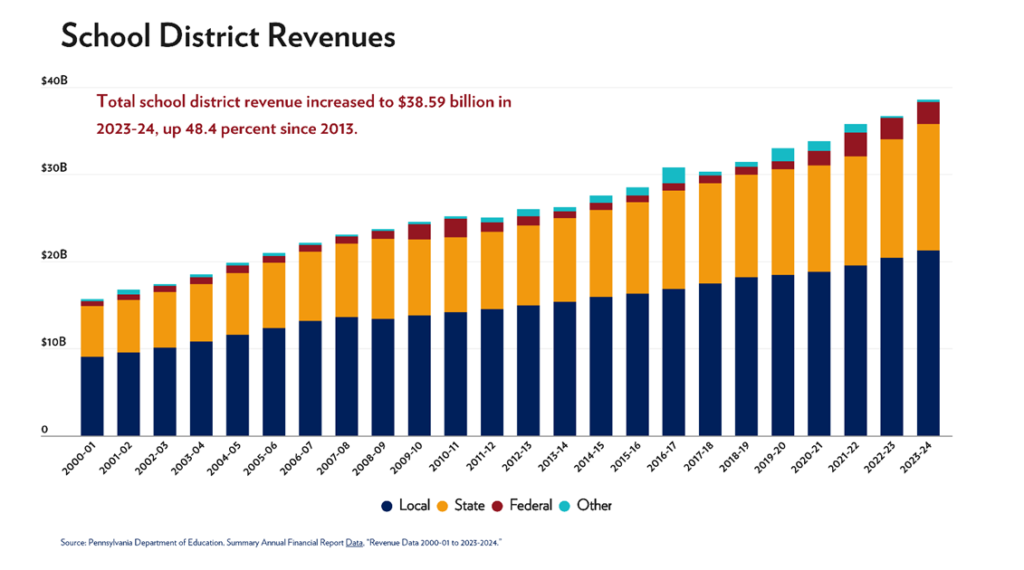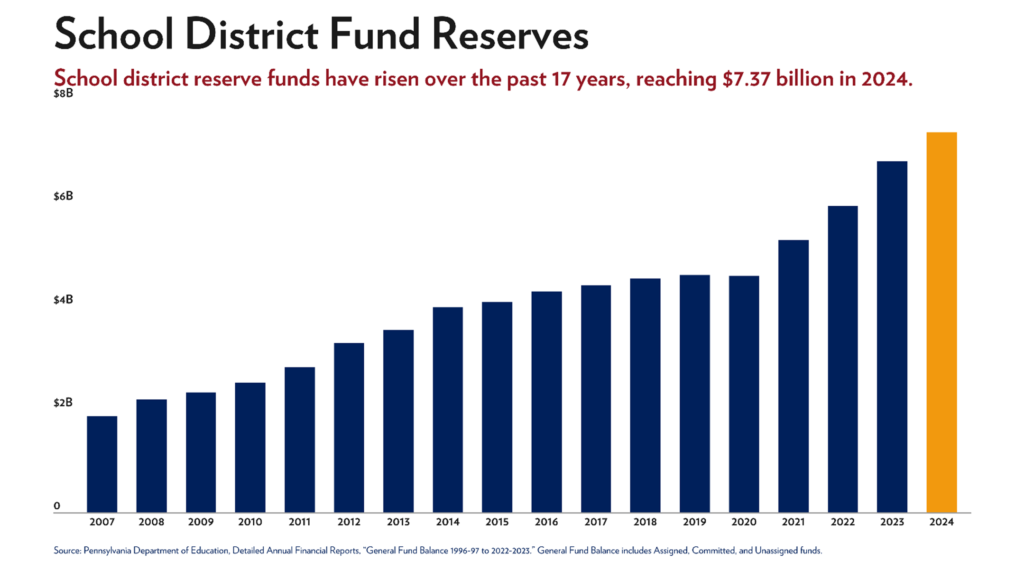Fact Sheet

Pennsylvania School Funding Reaches $23,000 per Student in 2024
Pennsylvania Public School Spending is Growing
- Public school spending reaches historic levels year after year.
- Pennsylvania public school revenue per student increased to $23,061 in the 2023-24 school year, up 44 percent since 2014–15, according to recent data from the Pennsylvania Department of Education (PDE).1
- Total school district revenues from all sources (local, state, and federal) increased to $38.6 billion in 2023–24.
- This predates a $1.2 billion increase for public schools in the 2024–25 state budget. State support of public schools increased $6.7 billion over the last decade.
- Pennsylvania’s per-student spending ranks seventh-highest in the nation, approximately $4,100 more per student than the national average (according to the latest available data from 2022).2

School District Reserve Funds at Excessive Levels
- School districts hold excessive stockpiles of taxpayer resources.
- School district reserves consist of assigned, unassigned, and committed funds.
- In 2023, Pennsylvania’s then-Auditor General, Timothy DeFoor, reported that school districts were misusing reserves by intentionally hiding funds in a “shell game” that allowed districts to raise taxes.
- The audit found “common yet questionable practices” among 12 school districts that raised taxes 37 of the 48 times during the timeframe studied—despite having sufficient funding of more than $360 million collectively—in their reserves.3
- The most recent PDE data reveals that school districts collectively hold $7.4 billion in reserve funds (as of 2023–24), up $557 million from the previous year.4
- School districts’ general fund reserves have continually increased over the past 17 years by an astronomical 294 percent, with a rapid hike of over 60 percent just since 2020.
- Claims that public schools remain inadequately or inequitably funded fail to take reserve funds into account. Lawmakers must balance demands for increased funding for public schools with a commonsense plan for addressing excessive reserve fund balances.5
- School district reserves consist of assigned, unassigned, and committed funds.

- Reserve funds should be no more than 20 percent of a school district’s total spending, according to the former Auditor General.6
- Fifty-seven percent of Pennsylvania’s 500 school districts have reserve funds exceeding 20 percent of their spending.
- Twenty-two districts have reserves at 50 percent or greater of their operating budget.
Despite Record Funding, Education Performance Lags
- Across Pennsylvania, Keystone exam scores show that 18 schools do not have a single student testing proficient in either English or math in 2024.7
- Among the low-achieving high schools, only 10 percent of students are proficient in math, and just one in three students demonstrates English language arts (ELA) proficiency.8
- The 2024 Pennsylvania System of School Assessment (PSSA) results show poor performance.
- About half of Pennsylvania’s fourth and eighth graders cannot read proficiently at grade level.
- More than half of Pennsylvania’s fourth graders and nearly 75 percent of the state’s eighth graders cannot perform math at grade level.
- Among students in third to eighth grades, only 18 percent are proficient in math and reading.
- Nationally, fewer than half of Pennsylvania’s public school students are proficient in any category. The 2024 National Assessment of Educational Progress (NAEP), or Nation’s Report Card, released in January, reveals that over two-thirds (69 percent) of the commonwealth’s eighth graders are not proficient in math and reading. Fourth-grade student proficiency scores are 41 percent in math and 31 percent in reading.9
- Testimony from the Independent Fiscal Office (IFO) notes “the data are less clear” regarding the relationship between spending and academic performance. The highest- and lowest-performing school districts each spent more than the state per-student average for regular instruction.10
Pennsylvania Needs to Tie District School Funding to Enrollment
- Enrollment is decreasing as spending is increasing.
- Pennsylvania public schools lost nearly 300,000 students from 2000–01 to the 2023–24 school year.11 Yet, revenue increased 146 percent.12
- PDE projects an enrollment decline of another 60,000 K–12 students by 2028.13
- Districts with shrinking enrollment receive more funds while districts with growing enrollment receive less.
- In 2014–15, Pennsylvania adopted a student-based funding formula for both basic education and special education. Yet a decade later, more than 95 percent of basic education and two-thirds of special education do not follow these student funding formulas.14

- Most state funding is doled out through “hold harmless.” Hold harmless is a decades-old practice that guarantees public school districts the same amount of state revenue as the previous year, regardless of enrollment changes.15
- The results: Districts with far fewer students than a decade ago receive significantly more state funding per student than districts with growing enrollment.16
- Tying state funding to enrollment would ensure that each student, especially those in high-poverty neighborhoods, receives adequate resources.
Pennsylvania Parents and Voters Want to Expand Educational Choice
- March 2025 polling shows seven out of ten Pennsylvanians support school choice.17
- Roughly the same number also supports specific program legislation, like that for the Pennsylvania Award for Student Success (PASS) or Lifeline Scholarships, to provide students assigned to low-achieving schools with the funding they need to attend a school of their choice.
- Two separate but similar initiatives are under consideration. PASS, as proposed in Senate Bill 10, has already passed the Senate Education Committee in an 8-3 vote and a forthcoming Lifeline Scholarship bill in the Pennsylvania House of Representatives would both provide Education Spending Accounts (ESA) to students residing within the attendance boundary of a school ranked in the bottom 15 percent of academic performance.18
- Polling in 2024 indicates that parents would choose private school education for their children if they could afford tuition. Wealthy families can afford to rent or buy a home in high-performing school districts, while low-income families cannot, perpetuating inequality. Expanding school choice in Pennsylvania ensures that all children—regardless of zip code, income, or race—have access to a high-quality school.
- Data shows that 85,570 low-income students currently receive tuition assistance under Pennsylvania’s Educational Improvement Tax Credit (EITC) and Opportunity Scholarship Tax Credit (OSTC) scholarship programs.
- However, the demand for tax credit scholarships far exceeds supply, with one out of two student scholarship applications unfulfilled due to arbitrary program caps.
- ESAs, as the PASS/Lifeline Scholarship legislation proposes, would directly fund students, giving families the resources they need for educational costs and delivering on the promise that every child has access to a quality education regardless of their zip code.
Conclusion
Pennsylvania now spends a new all-time high of $23,000 per student in public schools, amid ever-increasing state funding, taxes (state and local), and school district reserve funds—even as enrollment and test scores decline.
Instead of following a flawed funding formula and allowing districts to stockpile taxpayer dollars, state lawmakers should target education funding to follow students.
Expanding educational choice would ensure that “every student receives a meaningful opportunity to succeed” as required by the 2023 Commonwealth Court ruling.19
[1] Pennsylvania Department of Education, Annual Financial Report (AFR) Data Files, 2014–15 and 2022–23, https://www.education.pa.gov/Teachers – Administrators/School Finances/Finances/AFR Data Summary/Pages/default.aspx.
[2] Stephen Q. Cornman et al., “Revenues and Expenditures for Public Elementary and Secondary Education: School Year 2021–22 (Fiscal Year 2022),” (Washington D.C.: National Center for Education Studies, May 7, 2024), 7, https://nces.ed.gov/pubsearch/pubsinfo.asp?pubid=2024301.
[3] Pennsylvania Department of the Auditor General, “Auditor General DeFoor Questions Annual Property Tax Increases for 12 School Districts; Calls on Legislature to Close Loopholes,” news release, January 25, 2023, https://www.paauditor.gov/press-releases/auditor-general-defoor-questions-annual-property-tax-increases-for-12-school-districts-calls-on-legislature-to-close-loopholes; Auditor General Timothy DeFoor, “School Districts – General Fund Balances: Applying for Referendum Exceptions, Designating Funds, and Increasing Taxes,” (Harrisburg, PA: Department of the Auditor General, January 2023), https://www.paauditor.gov/Media/Default/Reports/speSchoolReservesAuditReport012523.pdf.
[4] Pennsylvania Department of Education, Annual Financial Report (AFR) Data: Detailed, “2023–24 AFR” and 2022–23 AFR,” accessed May 6, 2025, https://www.education.pa.gov/Teachers – Administrators/School Finances/Finances/AFR Data Summary/Pages/AFR-Data-Detailed-.aspx.
[5] Commonwealth Foundation, “Find Your School District’s Reserves,” May 5, 2025, https://www.commonwealthfoundation.org/research/school-reserves/.
[6] Jan Murphy, “School Districts Reserve Funds Continue to Grow, Amassing $4.3 Billion in 2014–15.” PennLive Patriot News, June 15, 2016, https://www.pennlive.com/politics/2016/06/school_districts_reserve_funds.html.
[7] Pennsylvania Department of Education, Keystone Exams: 2023 Keystone Results, https://www.education.pa.gov/DataAndReporting/Assessments/Pages/Keystone-Exams-Results.aspx.
[8] Pennsylvania Department of Education, PSSA Results: 2023 PSSA School Level Data.
[9] National Center for Education Statistics, “Nation’s Report Card: Pennsylvania Overview,” January 29, 2025, https://www.nationsreportcard.gov/profiles/stateprofile/overview/PA?chort=1&sub=MAT&sj=PA&sfj=NP&st=MN&year=2022R3&cti=PgTab_OT&fs=Grade.
[10] Matthew Knittel, “Testimony on the 2023 Basic Education Funding Commission Survey,” Independent Fiscal Office, December 15, 2023, http://www.ifo.state.pa.us/releases/729/Testimony-on-the-2023-Basic-Education-Funding-Commission-Survey/.
[11] Pennsylvania Department of Education, Public School Enrollment Reports, August 13, 2024, https://www.education.pa.gov/DataAndReporting/Enrollment/Pages/PublicSchEnrReports.aspx.
[12] Pennsylvania Department of Education, Education Budget, “2024–25 Preliminary Basic Education Funding” and “2024–25 Preliminary Special Education Funding,” February 2025, https://www.pa.gov/agencies/education/programs-and-services/schools/grants-and-funding/school-finances/education-budget.html.
[13] Pennsylvania Department of Education, Enrollment Projections, September 23, 2024, https://www.education.pa.gov/DataAndReporting/Enrollment/Pages/PublicSchEnrReports.aspx.
[14] Pennsylvania Department of Education, Education Budget, , “2024–25 Preliminary Basic Education Funding” and “2024–25 Preliminary Special Education Funding”; Pennsylvania Department of Education, “Historical Subsidy and Grant Information,” September 2024 [update], https://www.pa.gov/agencies/education/programs-and-services/schools/grants-and-funding/school-finances/financial-data/historical-subsidy-and-grant-information.html.
[15] Commonwealth Foundation, “2025 State of Education Spending in Pennsylvania,” January 22, 2025, https://commonwealthfoundation.org/research/2025-education-spending-pennsylvania/.
[16] Commonwealth Foundation, “Education Funding in the Commonwealth,” January 10, 2024, https://www.commonwealthfoundation.org/research/education-funding-commonwealth/.
[17] AFC Press, “New Polling Shows Widespread Support for School Choice in Pennsylvania,” April 9, 2025, https://afcpress.substack.com/p/new-polling-shows-widespread-support.
[18] Sen. Judy Ward et al., Senate Bill 10, Pennsylvania General Assembly, Regular Session 2025–26, https://www.palegis.us/legislation/bills/2025/sb10; Reps. Clint Owlett and Martina White, “Lifeline Scholarship Program,” Co-sponsor Memo, February 12, 2025, https://www.palegis.us/house/co-sponsorship/memo?memoID=45659.
[19] William Penn School District et al. v. PA Department of Education et al., 587 MD 2014, “Memorandum Opinion Filed” (February 7, 2023), https://www.pacourts.us/news-and-statistics/cases-of-public-interest/587-md-2014—william-penn-school-district-et-al-v-pa-department-of-education-et-al.